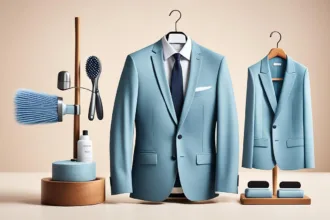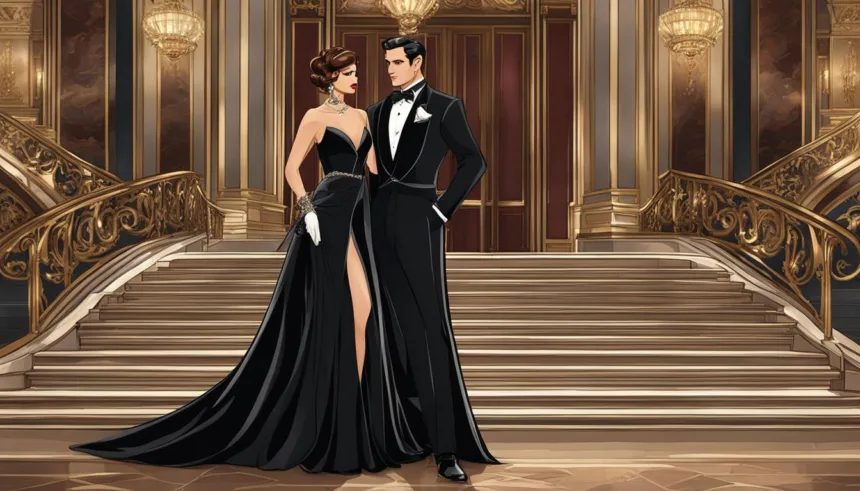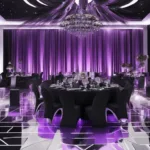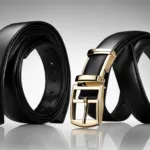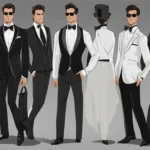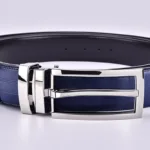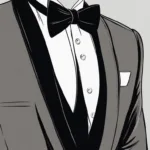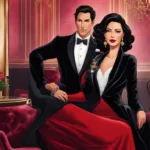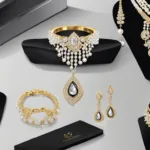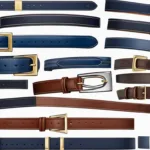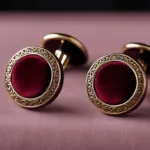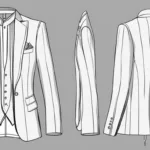Navigating the sartorial waters of a black tie event dress code can be akin to mastering an art form—one that embodies the pinnacle of sophistication at gala events. The invitation arrives, bearing the words “Black Tie” and immediately, the standard is set: elevated, elegant, and undeniably stylish. To partake in such an event is to embrace the finer aspects of fashion and to convey respect and appreciation for the ceremonious ambiance of the occasion.
Yet, what is the framework within which we work? Dress code etiquette for black tie events speaks to more than just the superficial appearance—it embraces a cultivated knowledge of garment selection, fitting, and accessories, all combined to create an air of distinctive poise. For men, it conjures visions of James Bond in his immaculate dinner suit; for women, it recalls Audrey Hepburn’s timeless grace. Each weave, fold, and fasten is a choice—one that reflects deference for the event’s formal tenor.
Understanding and following the guidelines for black tie outfits earns one not only a nod of approval from fashion mavens but, more importantly, a sense of personal triumph in mastering the conventions of high society’s wardrobe. It’s a delicate balance—fostering individual expression within the boundaries of classic tailoring and expectation, all while maintaining your bearing as the paragon of modern elegance.
Key Takeaways
- Black tie is the gold standard for evening wear at formal events, symbolizing a commitment to both tradition and luxury.
- Knowing the rules of black tie dress code showcases one’s cultural literacy and respect for the celebration and its hosts.
- Decoding dress code etiquette requires attention to detail, from selecting the appropriate level of formal attire to the precision of its execution.
- Integrating personal style within the framework of black tie dress code etiquette enhances the event’s elegance.
- Whether it’s the sheen of a patent leather shoe or the silhouette of a tuxedo, each element of a black tie outfit contributes to the sophistication of the gala experience.
The Essence of the Black Tie Event Dress Code
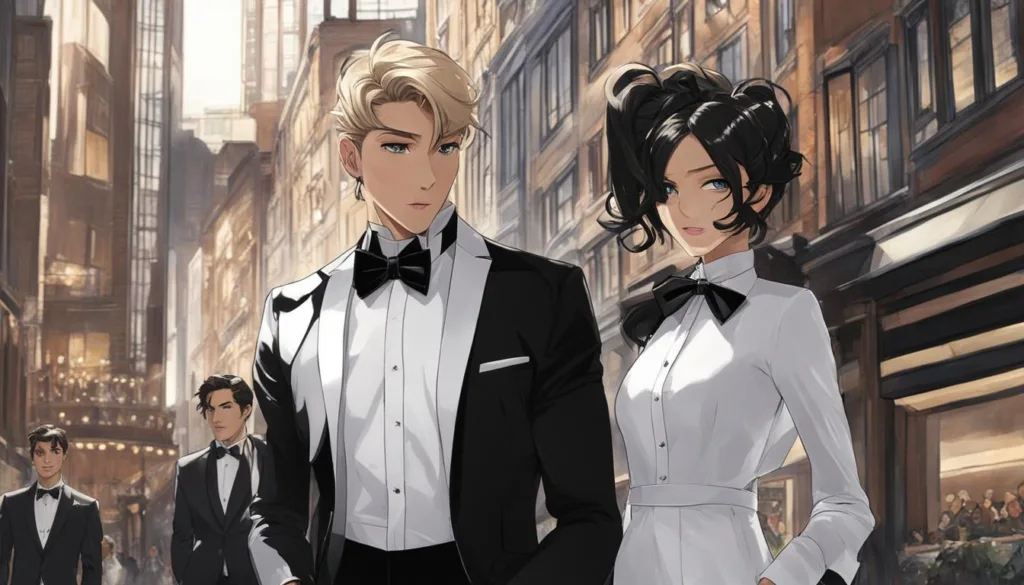
At the heart of every sophisticated soirée is the black tie event dress code, a sartorial standard that carries rich historical significance and reflects the très chic high society of yesteryears. This dress code has evolved, yet it retains core principles that define the epitome of formality and elegance at gala events.
The Historical Significance of Black Tie Attire
The black tie event dress code traces back to the 19th century. Its inception was a movement towards simplicity and understated elegance among the British aristocracy, notably replacing the more elaborate tailcoat with the dinner jacket. Since those halcyon days, black tie has remained a symbol of decorum, revered and preserved through various generations. With the grandeur of its origin, black tie ensembles have become fixtures in today’s formal festivities, from opulent fundraisers to intimate celebrations.
Key Components of a Classic Black Tie Ensemble
The quintessential black tie outfit meticulously combines several elements to harmonize with the traditional aesthetics of formality. For men, a classic black tie ensemble comprises:
- A sleek black tuxedo tailored to perfection
- A white formal shirt with a pleated front
- An elegant black bowtie, the understated centerpiece of the attire
- A black cummerbund or a low-cut waistcoat to anchor the look
- Black polished leather shoes, often in patent leather, for a lustrous finish
For women, a black tie event necessitates:
- A luxurious evening gown that drapes and flows with ceremonial grace
- Complementary accessories such as pearls or diamonds to add a refined sparkle
Black Tie vs. White Tie: Understanding the Distinction
The black tie dress code denotes a prestigious level of formal wear, yet it is overshadowed by the even more formal white tie—marked by its heightened requirements for sophistication. For men, the white tie dress code demands a tailcoat, an accessory conspicuously absent in black tie affairs. Meanwhile, women grace these occasions in full-length ball gowns, often with gloves that extend past the elbow, painting a portrait of unmatched elegance. Despite their differences, both dress codes are bound by an allegiance to the highest sartorial standards, defining moments where fashion elevates to an art form.
Selecting a Black Tie Suit: Style and Fit Tips

When it comes to selecting a black tie suit, discerning gentlemen know that style is paramount, but proper fit is what sets the sartorially savvy apart. As black tie events are the epitome of elegance, the suit you choose becomes a testament to your dedication to classic style and personal presentation. Savile Row tailors and luxury brands offer a plethora of options for those seeking the refined black tie suit style that has charmed icons of elegance for generations.
The first rule in selecting a black tie suit is to focus on the quality of the fabric. Luxurious materials like fine wool and gabardine not only look sumptuous but also perform well throughout an evening’s engagements. Beyond the fabric, attention to the tuxedo’s construction—satin lapels, a fully-lined jacket, and fabric-covered buttons—sets the tone for your entire look.
A proper fit for black tie cannot be overstated. The jacket should contour to the body, accentuating the shoulders and tapering at the waist, while trousers should fall cleanly over shoes with just the right break. To assist in visualizing, consider this comparison:
| Fit Aspect | Description | Style Impact |
|---|---|---|
| Jacket Waist | Slim but not tight | Enhances physique, offers sleek silhouette |
| Trousers Rise | Sits at natural waist | Lengthens legs, ensures elegant line from waist to foot |
| Sleeve Length | Ends just above the wrist | Allows for shirt cuff exposure |
| Trousers Break | Minimal to no break | Presents a modern, clean drape over shoes |
Small details like a ventless jacket back and perfectly hemmed trousers with a satin stripe affirm the adage that “God is in the details.” Achieving such a personalized fit may require the skilled hands of a bespoke tailor or the attentive service of a high-end menswear specialist.
A black tie event is more than just an outing; it’s a night where every detail speaks volumes. Whether attending a glamorous ball or an exclusive gala, your choice in suiting is a performance—a celebration of personal style within the boundaries of time-tested elegance. Remember, in the realm of black tie, the depth of style is as important as the suit itself.
The Ideal Black Tie Shirt Choices

At the zenith of any black tie affair, the apparel chosen speaks volumes, with the shirt playing a crucial role in this sartorial symphony. Making the right black tie shirt choices is not merely about aesthetic appeal but also about adhering to an unwritten code of sophistication and timeless elegance inherent in such celebrated gatherings.
Collar Styles for Black Tie Shirts
The decision of collar styles for black tie shirts significantly affects the overall look. Known for their formality, winged collars present a sharp silhouette that complements the traditional bow tie. Conversely, spread collars provide a contemporary alternative that works harmoniously with various tie widths — a modern nod within a classic framework.
Selecting Fabrics and Shirt Details
Fabric choice is paramount, with shirt fabrics such as Egyptian cotton standing at the pinnacle of both comfort and style. When delving into shirt details, the presence of French cuffs, meticulous pleats, and luxurious buttons like those crafted from mother-of-pearl serve to confidently elevate the black tie ensemble.
The Role of Shirt Color in Black Tie Events
The shirt color in black tie attire typically hews to the classic white, symbolizing purity and elegance. However, ivory can be an exquisite alternative, offering a warm complement to natural fabric tones and softer complexions, while still respecting the formal dress code.
Accessorizing Your Black Tie Outfit
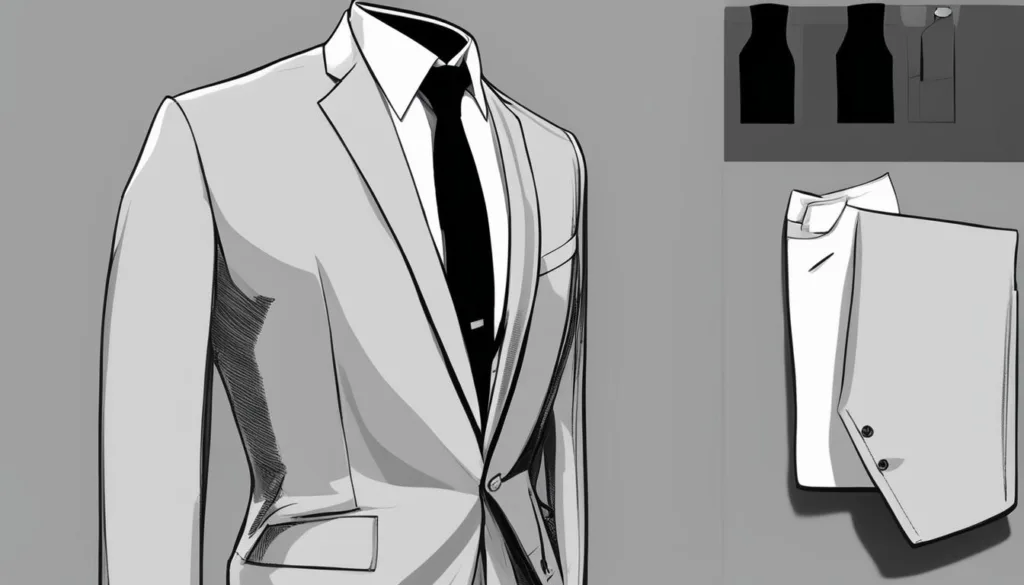
The transition from a classic black tie ensemble to a distinguished look is in the details. Accessories for black tie attire are not just decorative; they embody traditional formality with a hint of personal flair. From the subtle shimmer of cufflinks to the crisp fold of a pocket square, let us explore the essential elements that complete a gentleman’s gala attire and provide the needed sophistication for ladies’ evening gowns.
Choosing the Right Cufflinks and Studs
Essential for any gentleman’s black tie ensemble, cufflinks and studs are not only functional; they also offer a hint of individuality amidst strict dress codes. Selecting these items involves seeking quality materials and design:
| Material | Occasion | Visual Impact |
|---|---|---|
| Silver | Black Tie Galas | Clean, Refined Elegance |
| Gold | State Dinners, Awards Ceremonies | Warm, Sumptuous Shine |
| Mother-of-Pearl | Weddings, Corporate Events | Subtle Opulence with a Soft Lustre |
The ideal pairing of cufflinks and studs should align with the entirety of the outfit, complementing the wearer’s watch or other jewelry pieces for a cohesive and stylish look.
The Elegance of Pocket Squares and Vests
In black tie fashion, pocket squares add a dimension of style and color to a man’s tuxedo. Whether choosing silk or fine linen, the pocket square elevates the outfit with a touch of finesse:
- A brilliant white pocket square is classically paired with a black tuxedo for a timeless look.
- For a dash of color, select a hue that corresponds with your date’s attire or the evening’s theme without clashing with the bow tie.
Vests offer another layering option, providing an additional avenue for personal expression. Stick to a low-profile, single-breasted vest in solid colors to maintain the distinctive black tie elegance.
When and How to Wear Formal Gloves
Although less common in contemporary settings, formal gloves at events still have their place at the zenith of formality. Attributes to consider when incorporating gloves include:
- The occasion: reserve glove-wearing for winter galas or highly ceremonial affairs.
- The material: choose soft leather or silk gloves in white or gray.
- The style: opt for gloves that extend just beyond the wrist, avoiding bulky or elaborate designs.
When it comes time to dine or shake hands, remove gloves to display proper etiquette. They are not merely accessories but symbols of a bygone era of sartorial grandeur.
Proper Footwear for Black Tie Events
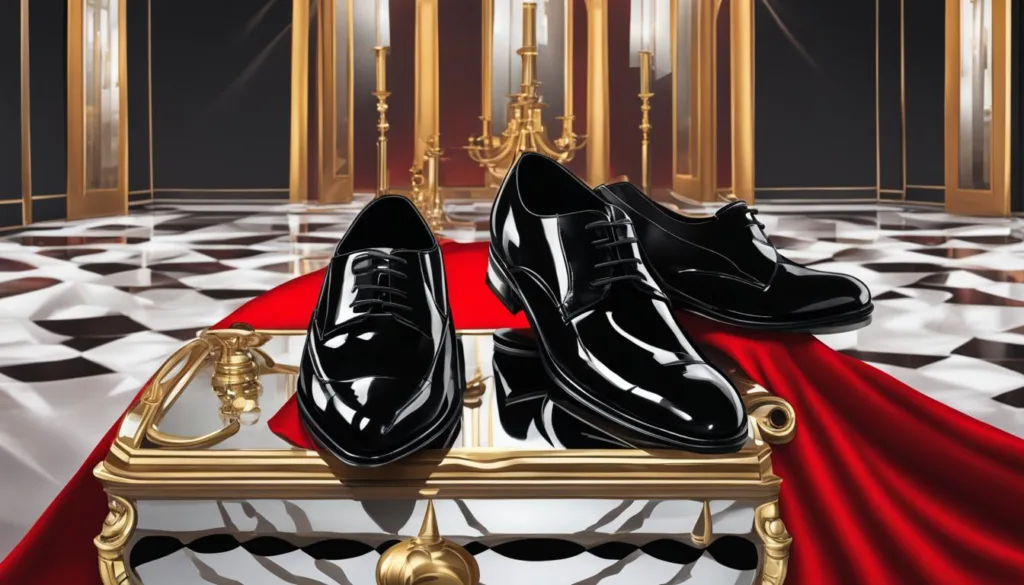
Selecting the proper footwear for black tie events is as crucial as picking out the suit or gown—it’s the detail that can elevate your look from good to great. For gentlemen, the clearest choice is black patent leather oxfords. The classic design and high shine complement a tuxedo’s sleekness and are essential for the sophisticated shoe choices expected at such upscale gatherings.
Ladies, on the other hand, have a variety of choices when it comes to footwear for a black tie event. The key is to strike a balance between elegance and comfort. High-heeled stilettos can exude glamour, while tasteful flats might be the preferred option for those who prioritize comfort or when the event involves more standing or dancing. Regardless, women’s black tie event shoes should be crafted from quality materials and match the sophistication of their dresses.
Remember that at black tie events, footwear is not merely a necessity but a statement of style. Choose wisely to walk with grace and confidence.
- For Men: Black patent leather oxfords are the archetypal selection due to their sheen and formality.
- For Women: Sophisticated shoe choices range from glamorous heels to elegant flats, catering to style preference and comfort needs.
When considering footwear for such an occasion, it’s important to keep in mind the venue as well. Outdoor events may call for shoes that can handle grass or uneven surfaces without sacrificing style.
| Men’s Footwear Option | Women’s Footwear Option | Considerations |
|---|---|---|
| Patent Leather Oxfords | High-Heeled Stilettos | Indoor events, polished floors |
| Dress Shoes (Non-Patent) | Elegant Flats | Outdoor events, longevity of wear |
| Polished Loafers | Satin or Velvet Pumps | Creative black tie, modern twist |
In conclusion, whether you opt for the timeless appeal of patent leather oxfords or the modern elegance of designer pumps, ensure your footwear reflects the grandeur of the event and aligns seamlessly with your ensemble. After all, sophisticated shoe choices are the finishing touch to any black tie look, providing the polish needed to navigate social gatherings with poise.
How to Tie a Bowtie for Events
Mastering the art of the bowtie is essential for achieving a polished look at black-tie events. The process of tying a bowtie is an esteemed tradition that distinguishes the well-appointed individual. Moreover, a hand-tied bowtie brings an authentic touch of sophistication that pre-tied versions simply cannot match. With a step-by-step bowtie guide, even novices can learn how to tie a bowtie for events with ease and style.
Step-by-Step Guide to Tying a Bowtie
To tie the traditional bow knot, begin by lifting your collar and draping the bowtie around your neck. The end on your right should extend roughly an inch lower than the end on your left. Cross the longer end over the shorter end and pull it through the loop at your neck to form a basic knot, much like the first step of tying your shoelaces. Then, fold the end that is now shorter into the bow shape you desire.
Bring the longer end over the center of the bow shape you have created. Folding the longer end, push it through the loop at the back of the bow structure from right to left. The trick is finding the small opening behind the bow to slip the end through. This maneuver forms the back half of the bowtie, so be sure to pull both halves taut.
How to tie a bowtie for events
Tighten the bow by pulling on opposite sides and adjusting as necessary for symmetry and tension. With each adjustment, ensure that your bowtie is snug, but not too tight, and the shape is balanced and proportional, perfectly centered between the collar tips.
Different Bowtie Knot Styles and When to Use Them
The bowtie has evolved into more than just a black-tie accessory. With a variety of bowtie knot styles available, individuals can choose the style that best complements their face shape, outfit, and the formality of the event. The classic butterfly, for example, features wide ends and is perfect for virtually any formal occasion. The narrower batwing style offers a more modern, streamlined look. Then there’s the diamond point with its asymmetric tips, adding a touch of flair.
| Bowtie Knot Style | Facial Shape Suitability | Event Formality |
|---|---|---|
| Classic Butterfly | Broad or Round Faces | All Black Tie Affairs |
| Narrow Batwing | Slim or Long Faces | Contemporary Events, Business Functions |
| Diamond Point | Angular Faces | Fashion-Forward Gatherings, Creative Black Tie |
Ultimately, the bowtie knot you select should embody both your personal aesthetic and respect for the event’s dress code. While the butterfly knot is a safe and universally appropriate choice for traditional black-tie events, feel free to experiment with batwing or diamond point styles to add a dash of individuality to your ensemble.
Deciphering Dress Code Guidelines for Black Tie Optional
When an invitation indicates Black tie optional, it presents guests with an opportunity to showcase their formal wear while allowing for individual preferences. This guidance on Black tie optional guidelines suggests a level of dress code flexibility that nods to formality but does not strictly demand it. Accordingly, this invitation leaves many wondering about attire selections including the tuxedo necessity for men and what constitutes an acceptable range of formalwear for women. Here’s how to finesse this dress code with etiquette and style.
Interpreting the Invitation: Is a Tuxedo Necessary?
For men, receiving a Black tie optional invitation might create a dilemma — is a tuxedo overkill, or is it still the preferred option? While a tuxedo continues to be a faultless choice, suggesting the utmost in male elegance, the Black tie optional dress code does provide room for alternatives. Adherence to the black tie aesthetic can be maintained through the selection of a well-tailored, dark suit. The importance lies in the suit’s cut, fit, and the quality of fabric, all of which should suggest a level of formality consistent with the event’s caliber. Here’s a quick checklist for men’s attire options:
- If opting for a suit instead of a tuxedo, choose a dark color such as midnight blue or charcoal grey for an evening-appropriate look.
- The shirt should be formal, ideally white, and accessorized with a conservative tie or a bow tie.
- Leather dress shoes should be polished to a shine, echoing the sophistication expected at such occasions.
Dress Code Flexibility: What Women Can Wear
Women attending events with a Black tie optional dress code enjoy a greater latitude in their fashion choices. A formal evening gown remains a classic and safe selection, exuding elegance and event-appropriateness. However, alternative options such as sophisticated cocktail dresses or an ensemble comprising of a formal blouse and dressy trousers also meet the requirements of this flexible dress code. Here are some considerations for women’s attire:
- Choose fabrics that mirror the event’s luxury, such as silk, satin, or velvet for an aura of elegance.
- Cocktail dresses are perfectly acceptable, particularly when they are of an appropriate length and made from luxe materials.
- Accessorize smartly with high-quality jewelry and clutch purses to elevate your look to black tie standards.
In essence, Black tie optional is a dress code that respects the sophisticated atmosphere of a black tie event while allowing for individual expression within a framework of formalwear. Whether you select a classic tuxedo or an elegant cocktail dress, your attire should harmonize with the setting and respect the hosts’ vision of their momentous occasion.
Black Tie Event Dress Code: The Female Perspective
When it comes to black tie attire for women, elegance and sophistication are paramount. This dress code, designed for the most formal events, traditionally involves women donning elegant gowns for black tie occasions that speak volumes of their sense of style and understanding of the event’s significance. These gowns are not just dresses, but vessels of luxury, featuring high-quality fabrics such as silk, velvet, and chiffon that gracefully skim the floor with each step.
While black remains a timeless and fail-safe choice, the modern take on female formal wear allows for an array of colors that make a statement. Bold jewel tones and understated neutrals can be equally appropriate, each able to exude the event’s required formality, especially when paired with impactful accessories like diamond or pearl earrings, stunning clutches, or elegant shoes.
For the woman who leans towards unconventional attire, a custom-fitted tuxedo or a chic tailored suit presents a bold alternative, reshaping the definition of black tie elegance. These choices symbolize a blend of power and femininity, signaling confidence and contemporary style.
Cocktail dresses, though traditionally reserved for semi-formal events, can sometimes find their place at black tie affairs. The conditional acceptance of such attire requires that the dress still encapsulates elements of grandeur and luxury, ensuring it is appropriate for the event’s sophistication.
| Attire Option | Description | Suggested Fabrics | Accessory Tips |
|---|---|---|---|
| Floor-Length Evening Gowns | Classic black tie attire for women, epitomizing elegance | Silk, Velvet, Chiffon | Complement with diamonds, pearls, or heirloom jewelry |
| Women’s Tuxedos | Modern twist on traditional formal wear, promoting a confident look | Wool, Blended Fabrics | Opt for minimalist jewellery and pointed-toe heels |
| Cocktail Dresses | Acceptable in more relaxed black tie settings, should still reflect luxury | Brocade, Sequin Embellished Fabrics | Accessorize with statement clutches and elegant heels |
The ambience of a black tie event is an exquisite canvas, on which women can display their individual style within the framework of formality. The perfect piece of formal wear for such an occasion strikes a balance between honoring traditions and personal expression, ensuring every woman feels at once unique and seamlessly in tune with the event’s storied elegance.
Modern Twists on Traditional Black Tie Attire
The classic black tie dress code, long-standing in tradition, has been gracefully ushering in modern adjustments that align with today’s diverse aesthetic landscape. Modern black tie attire is witnessing a transformation, bridging the gap between time-honored elegance and contemporary style sensibilities. At the intersection of culture, fashion, and sophistication, one finds a refreshed interpretation of what it means to dress up for the most formal of events.
Incorporating Contemporary Trends
Contemporary trends in formal wear are redefining the boundaries of the black tie ethos. The infusion of fashion-forward elements such as edgy geometric cuts, avant-garde adornments, and unexpected textures is adding a layer of modernity to conventional silhouettes. It’s how a velvet tuxedo jacket might receive a splash of midnight blue or a bespoke gown may be adorned with sculpted ruffles—these are the artistic choices that reflect modernity without forsaking the grandeur of traditional formal wear.
Cultural and Fashion Influences on Black Tie Attire
The rich tapestry of global cultures has always been a source of inspiration for fashion, and black tie attire is no exception. Cultural influences make their mark on the black tie scene through vibrant hand-woven fabrics or intricate embroidery patterns distinct to certain regions. It’s not uncommon to see a silk mandarin collar on a dinner jacket as a subtle nod to Asian influence or the silhouette of a classic European cut infused with the flamboyance of Latin American flourish.
The integration of these elements represents not only the evolution of fashion but also the progressive mindset of society—a willingness to embrace innovation while paying homage to the aesthetic foundations laid by the generations before. Thus, as we celebrate today and look towards tomorrow, we see that modern black tie attire is less about strict rules and more about a living dialogue between the past and the present.
Conclusion
The realm of black tie events is one that demands a high level of care and attention to personal presentation. The elegance of these occasions is not incidental but the result of meticulous adherence to a dress code that stands as the bastion of formality. Abiding by the black tie dress code is more than just a fashion statement; it’s a gesture of reverence to the event’s hosts and a demonstration of one’s ability to navigate social customs with grace and respect.
The Importance of Adhering to the Black Tie Event Dress Code
Adherence to the black tie dress code is paramount in ensuring the ambiance of any gala or sophisticated gathering remains seamless. It reflects an understanding that such events are not merely gatherings but cultivated experiences where every detail contributes to the tapestry of elegance. Wearers become part of a ceremonial display, exuding an aura of class that is both expected and admired in high society. By fully embracing this dress code, attendees unite in a visual harmony, thereby honoring the very essence of the celebration.
Final Thoughts on Mastering Sophisticated Style for Black Tie
Mastering sophisticated style for a black tie event goes beyond donning the sharpest tuxedo or the most stunning gown. It means discerning the nuances of fabric choices, cuts, and fits that define timeless appeal. In this light, the black tie event elegance becomes a canvas for personal expression within the well-established customs of formality. Class and refinement are the core principles that anchor black tie attire, inviting each guest to not only partake but to shine within the refined world of grand soirees. Embrace these truths, and you will find that any black tie event is an opportunity to illustrate sophistication at its peak.
